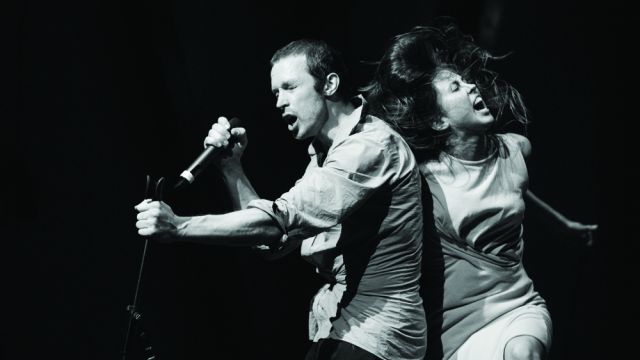Complexity of Belonging
The deep stage of the Sumner Theatre is backed by a cyclorama depicting a vast, indifferent outback sky, the horizon a mere streak. Such is the lonely setting, designed by Robert Cousins, in which the show asks the questions, ‘Who belongs? And how do they belong?’
There may be those who do ‘belong’ – to a person, to a place – but they are not the characters of this show. There’s an outsider journalist (Eloise Mignon) who has arrived here to research and write about various people’s conceptions of ‘belonging’. There’s a European therapist (Karen Sibbing) who has come to mystifying Australia to be with her lover (Joel Bray), but the nature of his job ensures that he is perpetually somewhere else. There’s a fellow (Josh Price) with some indigenous ancestry, enough to talk about it, but not really… Tara Soh and James Vu Ahn Pham represent an Asian minority that isn’t quite ‘integrated’ and Mr Vu Ahn Pham has a funny but angry (or angry but funny) monologue in which an ‘Asian’ expresses the same attitude to white Australians as the original white English took to Aboriginal people. The laughter was a little uneasy after that one.
There are about a dozen modular grey lounge chairs that can be arranged to represent, say, an airport departure lounge, or they can be piled up to make a small mountain or a pit to hide in. But when a performer scuds across the stage in one of them, I’m lost. In front of the cyclorama, a screen mounted on scaffolding looks like nothing so much as a drive-in movie screen. The show combines images (projected onto that screen), brief dialogue scenes, monologues and, of course, brilliant, precise, but seemingly loose-limbed dancing. These dancers turn out to be very good – and funny – actors too.
It is a rich mix, but one that successfully combines all its elements somewhat intermittently. At times there are simply too many seemingly disparate things going on at once and you don’t know where to look. While half the cast, say, dance in movement suggesting some sort of panic, should we watch them or focus our attention on the dialogue scene upstage when the two things don’t seem to be connected? To pick only one seems, well, to be missing the other, but to focus on both means grasping neither.
But when movement, image, text and dance do all integrate and bounce off each other in a coherent whole, Complexity of Belonging is brilliant.
A fine example (and one of the most memorable set pieces of the show) has Lauren Langlois listing the qualities of the ‘perfect man’ to her therapist. It’s a very long list of well worn clichés. Ms Langlois, known as a dancer, never falters. She continues her catalogue of necessary attributes, still talking as she is snatched into a pas de deux in which she is laid down, picked up, dropped, folded, unfolded, turned over, turned back, her limbs seemingly separated from her torso. While this proceeds, a ‘man’ (Joel Bray) lines up about eight of those grey chairs with spaces between and leaps from one to another, and then jumps from one to another. Instinctively, you see this as a ‘test’. It should be a distraction, but it’s not; it’s a comprehensible comment or parallel to the monologue. He will try to impress, but he’ll never be the ‘perfect man’ and she will never find one. The whole piece is so clear and done so well, especially by Ms Langlois, and so funny – and awful - that it gets sustained applause.
But should similar demands for meaning be placed on the whole show? Probably. The problem with mixing words, images and movement is that we tend to demand more rational ‘meaning’ from the movement and the images. The story premise of the journalist’s interviews is stretched pretty thin, and when the journalist has her own monologues, offering some sort of overview or interpretation, the text is either gratingly pretentious or a satire on such attempts. Probably the latter: the show is taking the piss out of her too.
‘Only connect,’ said EM Forster and that injunction underlies this production. It’s about ‘belonging’, but there’s no belonging without connection and themes of isolation and loneliness predominate. If that sounds like a dark and depressing evening, be reassured: Complexity is overwhelmingly funny. In that sense, it’s Australian. ‘Got a problem? Don’t take yourself so seriously! Watch us send you up! We’re whistling in the dark. We’re laughing through the pain.’ Throughout the show, I was reminded again and again of the work of Robert Le Page – more by the tone than any strict equivalents. Beside a pretty rambling, catch-all structure (although Le Page has far more story per se), this show from Chunky Move has its way of dealing with modern angst and alienation and that is humour – and humour expressed in layers, in startling juxtapositions and confrontations. Not everything comes off here, but the attempt is bold, exciting and more satisfying than not.
As usual with this company, you admire enormously the dancing and the choreography, but you are also uplifted by the ideas that exhibit nerve and resilience in the face of so much sadness.
Michael Brindley
Subscribe to our E-Newsletter, buy our latest print edition or find a Performing Arts book at Book Nook.

